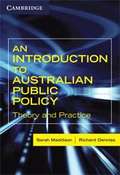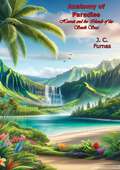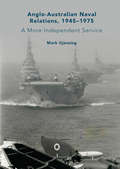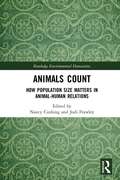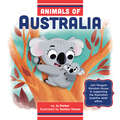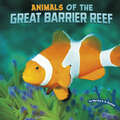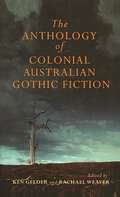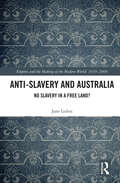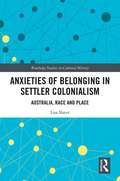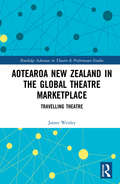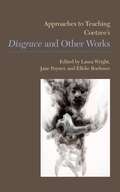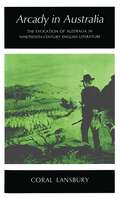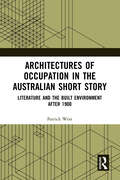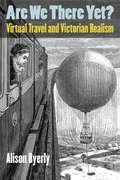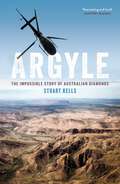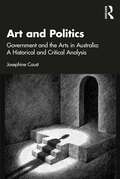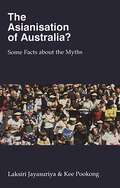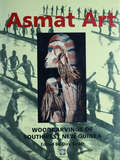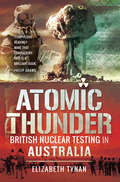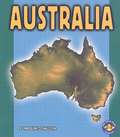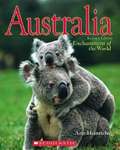- Table View
- List View
An Introduction To Australian Public Policy
by Sarah Maddison Richard DennissAn Introduction to Australian Public Policy: Theory and Practice is the first book to comprehensively address both the theoretical and practical aspects of policy making in Australia. Written in an accessible style, this text is designed to introduce students to the real world challenges and skills involved in working in a range of policy roles. Drawing on their own experiences, the authors ground public policy theory in a number of key controversies to illustrate the contestable nature of the policy process. Each chapter features case studies that outline contemporary policy issues, such as the deregulation of the financial system, 'Knowledge Nation', paid maternity leave, and the Northern Territory intervention. Including practical exercises on how to write policy briefs and media releases, this book is essential reading for anyone who needs to know how public policy is developed in Australia.
An Introduction to Australian Public Policy
by Sarah Maddison Richard DennissThe public policy arena is a complex framework of actors, politics and instruments. An Introduction to Australian Public Policy Second Edition examines the broad range of models, influences and players that shape the development of public policy in Australia, and equips students with a working knowledge of both the theoretical underpinnings and real-world challenges of the field. Fully revised and updated, the new edition addresses the diverse approaches to policy formulation required by different practitioners and institutions. Accessible and engaging, this edition includes: a new chapter on policy evaluation; practical exercises on how to write policy briefs and media releases and eleven new, concise case studies from Australia's top public policy practitioners. The book is accompanied by a companion website which contains chapter summaries and a glossary. Widely regarded as the best introduction to Australian public policy available, the book is an essential resource for undergraduate students of politics and policy workers.
An Introduction to Australian Public Policy
by Sarah Maddison Richard DennissAn Introduction to Australian Public Policy: Theory and Practice is the first book to comprehensively address both the theoretical and practical aspects of policy making in Australia. Written in an accessible style, this text is designed to introduce students to the real world challenges and skills involved in working in a range of policy roles. Drawing on their own experiences, the authors ground public policy theory in a number of key controversies to illustrate the contestable nature of the policy process. Each chapter features case studies that outline contemporary policy issues, such as the deregulation of the financial system, 'Knowledge Nation', paid maternity leave, and the Northern Territory intervention. Including practical exercises on how to write policy briefs and media releases, this book is essential reading for anyone who needs to know how public policy is developed in Australia.
Anatomy of Paradise Hawaii and the Islands of the South Seas
by J. C. FurnasEmbark on an enchanting journey through the idyllic islands of the Pacific with J. C. Furnas's Anatomy of Paradise: Hawaii and the Islands of the South Seas. This captivating travel narrative offers a rich and detailed exploration of the cultures, landscapes, and histories of Hawaii and the South Sea Islands, capturing the essence of these paradisiacal destinations.Furnas, a skilled writer and keen observer, provides readers with a comprehensive account of his travels through some of the world's most breathtaking and remote locales. From the volcanic majesty of Hawaii to the serene beauty of Tahiti and Fiji, Anatomy of Paradise vividly portrays the natural splendor and unique cultural heritage of each island.The book delves into the complex history of the Pacific Islands, tracing their journey from ancient Polynesian navigators to encounters with European explorers and the impact of colonialism. Anatomy of Paradise is not just a travelogue; it is an exploration of the human spirit and its connection to these enchanting lands. Furnas highlights the resilience, traditions, and daily lives of the islanders, providing a respectful and empathetic portrayal of their societies. His engaging prose brings to life the rhythms of island life, from traditional ceremonies and dances to the challenges of modernity.This book is an essential read for travel enthusiasts, historians, and anyone fascinated by the Pacific Islands. Furnas's evocative storytelling and thorough research create a vivid tapestry of the islands, making Anatomy of Paradise a timeless tribute to one of the world's most captivating regions.Join J. C. Furnas on this unforgettable journey and experience the magic, mystery, and beauty of Hawaii and the Islands of the South Seas through the eyes of a masterful storyteller.
Anglo-Australian Naval Relations, 1945–1975: A More Independent Service
by Mark GjessingThis book examines Anglo-Australian naval relations between 1945-75, a period of great change for both Australia and Great Britain and their respective navies. It explores the cultural and historical ties between the Royal Navy and the Royal Australian Navy (RAN), the efficacy of communications between the services, and the importance of personal relations to the overall inter-service relationship. The author assesses the dilemmas faced by Great Britain associated with that nation’s declining power, and the impact of the retreat from ‘East of Suez’ on the strategic relationship between the United Kingdom and Australia. The book also considers operational co-operation between the Royal Navy and the RAN including conflicts such as the Korean War, the Malayan Emergency, and confrontation with Indonesia, as well as peacetime pursuits such as port visits and the testing of atomic weapons in the 1950s. Co-operation in matters of personnel and training are also dealt with in great detail, along with the co-operation between the Royal Navy and the RAN in equipment procurement and design and the increased ability of the RAN to look to non-British sources for equipment procurement. The book considers the impact of stronger Australian-American ties on the RAN and appraises the role it played in the conflict in Vietnam.
Animals Count: How Population Size Matters in Animal-Human Relations (Routledge Environmental Humanities)
by Nancy Cushing Jodi FrawleyWhether their populations are perceived as too large, just right, too small or non-existent, animal numbers matter to the humans with whom they share environments. Animals in the right numbers are accepted and even welcomed, but when they are seen to deviate from the human-declared set point, they become either enemies upon whom to declare war or victims to be protected. In this edited volume, leading and emerging scholars investigate for the first time the ways in which the size of an animal population impacts how they are viewed by humans and, conversely, how human perceptions of populations impact animals. This collection explores the fortunes of amphibians, mammals, insects and fish whose numbers have created concern in settler Australia and examines shifts in these populations between excess, abundance, equilibrium, scarcity and extinction. The book points to the importance of caution in future campaigns to manipulate animal populations, and demonstrates how approaches from the humanities can be deployed to bring fresh perspectives to understandings of how to live alongside other animals.
Animals of Australia
by Jo ParkerExplore the Australian Outback to find koalas, kangaroos, crocodiles, and more!Did you know kangaroos can jump 10 feet high? And they can travel up to speeds of 40 miles per hour!Learn more fun facts about some of Australia's favorite animals! In connection with the publication of Animals of Australia, Penguin Random House will donate a portion of the proceeds to support efforts to provide Australian bushfire relief.
Animals of the Great Barrier Reef (Wild Biomes)
by Martha E. RustadBiomes are home to unique animals and plants. Introduce beginning readers to the Great Barrier Reef! Readers will get an up-close look at the characteristics of the reef and how corals, fish, anemones, rays, birds, and other animals have adapted to life in and around this amazing biome.
Anthology Of Australian Colonial Gothic Fiction
by Ken Gelder Rachael WeaverGrisly corpses, ghostly women and psychotic station-owners populate an unforgiving landscape that is the stuff of nightmares. These compelling stories are the dark underside to the usual story of colonial progress, promise and nation-building, and reveal the gothic imagination that lies at the heart of Australian fiction. This anthology collects the best examples of colonial Australian gothic short stories by authors such as Marcus Clarke, Hume Nisbet, Henry Lawson and Katherine Susannah Prichard, among others.
Anti-Slavery and Australia: No Slavery in a Free Land? (Empire and the Making of the Modern World, 1650-2000)
by Jane LydonBringing the histories of British anti-slavery and Australian colonization together changes our view of both. This book explores the anti-slavery movement in imperial scope, arguing that colonization in Australasia facilitated emancipation in the Caribbean, even as abolition powerfully shaped the Settler Revolution. The anti-slavery campaign was deeply entwined with the administration of the empire and its diverse peoples, as well as the radical changes demanded by industrialization and rapid social change in Britain. Abolition posed problems to which colonial expansion provided the answer, intimately linking the end of slavery to systematic colonization and Indigenous dispossession. By defining slavery in the Caribbean as the opposite of freedom, a lasting impact of abolition was to relegate other forms of oppression to lesser status, or to deny them. Through the shared concerns of abolitionists, slave-owners, and colonizers, a plastic ideology of ‘free labour’ was embedded within post-emancipation imperialist geopolitics, justifying the proliferation of new forms of unfree labour and defining new racial categories. The celebration of abolition has overshadowed post-emancipation continuities and transformations of slavery that continue to shape the modern world.
Anxieties of Belonging in Settler Colonialism: Australia, Race and Place (Routledge Studies in Cultural History #65)
by Lisa SlaterThis book analyses the anxiety "well-intentioned" settler Australian women experience when engaging with Indigenous politics. Drawing upon cultural theory and studies of affect and emotion, Slater argues that settler anxiety is an historical subjectivity which shapes perception and senses of belonging. Why does Indigenous political will continue to provoke and disturb? How does settler anxiety inform public opinion and "solutions" to Indigenous inequality? In its rigorous interrogation of the dynamics of settler colonialism, emotions and ethical belonging, Anxieties of Belonging has far-reaching implications for understanding Indigenous-settler relations.
Aotearoa New Zealand in the Global Theatre Marketplace: Travelling Theatre (Routledge Advances in Theatre & Performance Studies)
by James WenleyAotearoa New Zealand in the Global Theatre Marketplace offers a case study of how the theatre of Aotearoa has toured, represented and marketed itself on the global stage. How has New Zealand work attempted to stand out, differentiate itself, and get seen by audiences internationally? This book examines the journeys of a dynamic range of culturally and theatrically innovative works created by Aotearoa New Zealand theatre makers that have toured and been performed across time, place and theatrical space: from Moana Oceania to the Edinburgh Festival Fringe, from a Māori Shakespeare adaptation to an immersive zombie theatre experience. Drawing on postcolonialism, transnationalism, cosmopolitanism and globality to understand how Aotearoa New Zealand has imagined and conceived of itself through drama, the author investigates how these representations might be read and received by audiences around the world, variously reinforcing and complicating conceptions of New Zealand national identity. Developing concepts of theatrical mobility, portability and the market, this study engages with the whole theatrical enterprise as a play travels from concept and scripting through to funding, marketing, performance and the critical response by reviewers and commentators. This book will be of global interest to academics, producers and theatre artists as a significant resource for the theory and practice of theatre touring and cross-cultural performance and reception.
Approaches to Teaching Coetzee's Disgrace and Other Works (Approaches to Teaching World Literature #130)
by Laura Wright, Jane Poyner, and Elleke BoehmerThe novels of the South African writer J. M. Coetzee won him global recognition and the Nobel Prize in Literature in 2003. His work offers substantial pedagogical richness and challenges. Coetzee treats such themes as race, aging, gender, animal rights, power, violence, colonial history and accountability, the silent or silenced other, sympathy, and forgiveness in an allusive and detached prose that avoids obvious answers or easy ethical reassurance.Part 1 of this volume, "Materials," identifies secondary materials, including multimedia and Internet resources, that will help instructors guide their students through the contextual and formal complexities of Coetzee's fiction. In part 2, "Approaches," essays discuss how to teach works that are sometimes suspicious of teachers and teaching. The essays aim to help instructors negotiate Coetzee's ironies and allegories in his treatment of human relationships in a changing South Africa and of the shifting connections between human beings and the biosphere.
Arcady in Australia: The evocation of Australia in nineteenth-century English Literature
by Coral LansburyThis provocative book examines the vision of Australia in nineteenth-century English literature. The industrial revolution destroyed the myth of an idyllic rural way of life in England, and writers like Charles Dickens, Bulwer Lytton and Charles Reade created it anew in the improbable environment of Australia. The popular image of Australia in English literature was Arcadian; in turn it dominated the thought and traditions of writing in Australia. The man who supplied the material for English writers was Samuel Sidney; he was for a time regarded as an expert on Australia, although he had never set foot in the antipodes and all his material was second-hand. His influence on the literature of the period, and consequently on Australia, has received scant attention. Sidney's influence is fully examined; the book also offers entirely new material on Wakefield, Dickens, Lytton and Reade. It provides a new and challenging interpretation of literature and social history in both England and Australia.
Architectures of Occupation in the Australian Short Story: Literature and the Built Environment after 1900
by Patrick WestPatrick West’s Architectures of Occupation in the Australian Short Story cultivates the potential for literary representations of architectural space to contribute to the development of a contemporary politics of Australian post-colonialism.West argues that the predominance of tropes of place within cultural and critical expressions of Australian post-colonialism should be re-balanced through attention to spatial strategies of anti-colonial power. To elaborate the raw material of such strategies, West develops interdisciplinary close readings of keynote stories within three female-authored, pan-twentieth century, Australian short-story collections: Bush Studies by Barbara Baynton (1902); Kiss on the Lips and Other Stories by Katharine Susannah Prichard (1932); and White Turtle: A Collection of Short Stories by Merlinda Bobis (1999). The capacity of the short-story form to prompt creative and politically germinal engagements with species of space associated with architecture and buildings is underscored. Relatedly, West argues that the recent resurgence of binary thought—on local, national, and international scales—occasions an approach to the short-story collections shaped by binary relationships like a dichotomy of inside and outside. Concluding his argument, West connects the literary and architectural critiques of the story collections to the wicked problem, linked to ongoing colonial violences, of improving Australian Indigenous housing outcomes.Innovative and interdisciplinary, this book will be of interest to scholars and students of Literary, Architectural, and Postcolonial Studies. .
Are We There Yet?: Virtual Travel and Victorian Realism
by Alison ByerlyAre We There Yet? Virtual Travel and Victorian Realism connects the Victorian fascination with "virtual travel" with the rise of realism in nineteenth-century fiction and twenty-first-century experiments in virtual reality. Even as the expansion of river and railway networks in the nineteenth century made travel easier than ever before, staying at home and fantasizing about travel turned into a favorite pastime. New ways of representing place—360-degree panoramas, foldout river maps, exhaustive railway guides—offered themselves as substitutes for actual travel. Thinking of these representations as a form of "virtual travel" reveals a surprising continuity between the Victorian fascination with imaginative dislocation and twenty-first -century efforts to use digital technology to expand the physical boundaries of the self.
Argyle: The Impossible Story of Australian Diamonds
by Stuart KellsThe remote Kimberley region of Western Australia has a rich history and unique geography. In the 1960s De Beers, the world's largest diamond company, sent gem-hunters to the area but they came away empty-handed. It was a vast region to survey, and they'd overlooked something vital. A few years later, a team of Australian geologists with a tiny budget searched for even tinier mineral clues. Those clues led them to the earth's largest diamond deposit and the world's richest source of rare pink diamonds. Based on in-depth research and interviews - including with Alan King Jones, Bill Leslie and 'the father of Australian diamonds', Ewen Tyler - Argyle: The Impossible Story of Australian Diamonds details the almost overwhelming challenges with realising a diamond mining venture in Australia, shows how these obstacles were overcome, and explores the mine's impact and legacy.
Art and Politics: Government and the Arts in Australia: A Historical and Critical Analysis
by Josephine CaustAustralian governments at all levels have been engaged with arts and culture in many different forms since the beginning of European settlement. The way this has occurred is documented and analysed here, both from an historical and critical perspective. Changing understandings of culture and the significance of Indigenous Culture to Australia receive special attention. While the focus is primarily directed to Federal Government engagement, there is also consideration paid to both state and local government involvement. There is attention paid to the censorship of arts practice by governments as well as the direct interventions by politicians in arts practice. Different approaches to the arts by governments are also considered, as well as attempts to develop a national cultural policy. The impact of the recent pandemic is addressed and various research reports about the arts sector and its relationship with government are also noted. There is then a final discussion about some issues that governments could address in the future, that might ensure a more sustainable Australian arts sector. This book will be of particular interest to scholars of contemporary arts, arts management, cultural history, public policy and cultural policy. It may also interest bureaucrats and politicians.
Ash Road
by Ivan SouthallA raging fire spreading in the Australian bush cuts off the escape of the children and two old men entrusted to their care.
Asianisation Of Australia?: Some Facts about the Myths
by Kee Pookong Laksiri Jayasuriya'. . . we must combat blind ignorance with fact, and unreason with reason, and that is what this book is about.' Don Dunstan Pauline Hanson was not the first person to sensationalise the effects of Australia's open immigration policy on the racial make-up of this country. Nor was she the first politician to see advantage in building on the fear and prejudice beneath the surface of Australia's multicultural society. For the end of the White Australia policy in 1973 did not spell the end of fear of a peaceful Asian invasion through immigration. The Asianisation of Australia? contributes the dispassionate, independent and objective comment that has been missing from media debate on the effects of our immigration policies. It provides a wealth of data on the make-up of Australia's immigrant intake and the ability of immigrants to establish a place in their new country. Recent political rhetoric and forecasts are exposed for the myths, prejudices and over-simplifications that they are. By comparing such indicators as rates of employment, income, childbirth, intermarriage and fluency in English between Asian and other immigrants, Professors Jayasuriya and Kee convincingly demonstrate the valuable contribution made by Asian immigrants to our culture and our economy.
Asmat Art
by Dirk SmidtThis book presents a full range of Asmat woodcarving art, but emphasizes the rare early shields and figure sculptures in the collection of the Rijksmuseum voor Volkenkunde, the National Museum of Ethnology in Leiden. Drums, canoeprowheads and the larger, more dramatic "objects" are also shown. * Together with bisj poles, war shields are perhaps the most famous creation of Asmat artists, and these were carved throughout the region. It is in the design and construction of the shields that the variations in style region can most clearly be seen. Figure sculptures, of varying styles, are also well represented here, and a limited number of the huge ceremonial carvings, such as bisj poles and basu suangkus, have also been included. The cultural context in which these items play their part is described in detail in the introductory chapters. But it is not the intention of this book to be an ethnography. The focus is on the art pieces themselves.
Asmat Art
by Dirk SmidtThis book presents a full range of Asmat woodcarving art, but emphasizes the rare early shields and figure sculptures in the collection of the Rijksmuseum voor Volkenkunde, the National Museum of Ethnology in Leiden. Drums, canoeprowheads and the larger, more dramatic "objects" are also shown. * Together with bisj poles, war shields are perhaps the most famous creation of Asmat artists, and these were carved throughout the region. It is in the design and construction of the shields that the variations in style region can most clearly be seen. Figure sculptures, of varying styles, are also well represented here, and a limited number of the huge ceremonial carvings, such as bisj poles and basu suangkus, have also been included. The cultural context in which these items play their part is described in detail in the introductory chapters. But it is not the intention of this book to be an ethnography. The focus is on the art pieces themselves.
Atomic Thunder: British Nuclear Testing in Australia
by Elizabeth TynanAn in-depth account of Great Britain&’s atomic testing efforts in South Australia in the 1950s and &’60s, and its effects. British nuclear testing took place at Maralinga, South Australia, between 1956 and 1963, after Australian Prime Minister Robert Menzies had handed over 3,200 square kilometres of open desert to the British Government, without informing his own people. The atomic weapons test series wreaked havoc on Indigenous communities and turned the land into a radioactive wasteland. How did it come to pass that a democracy such as Australia suddenly found itself hosting another country&’s nuclear program? And why has it continued to be shrouded in mystery, even decades after the atomic thunder clouds stopped rolling across the South Australian test site? In this meticulously researched and shocking work, journalist and academic Elizabeth Tynan reveals the truth of what really happened at Maralinga and the devastating consequences of what took place there, not to mention the mess that was left behind.Praise for Atomic Thunder &“Compulsive reading? Make that compulsory. This is a brilliant book.&” —Philip Adams
Australia
by Madeline DonaldsonAustralia is the smallest continent, and the only continent that is also made up of only one country. It is home to over twenty million people, as well as a large variety of plants and animals that exist nowhere else in the world. Learn more about the land down under in this fascinating book.
Australia (Enchantment of the World)
by Ann HeinrichsIn a comprehensive series designed to showcase particular features of a country, this book provides maps, timeline, fast facts, charts, and vivid photographs on Australia.
